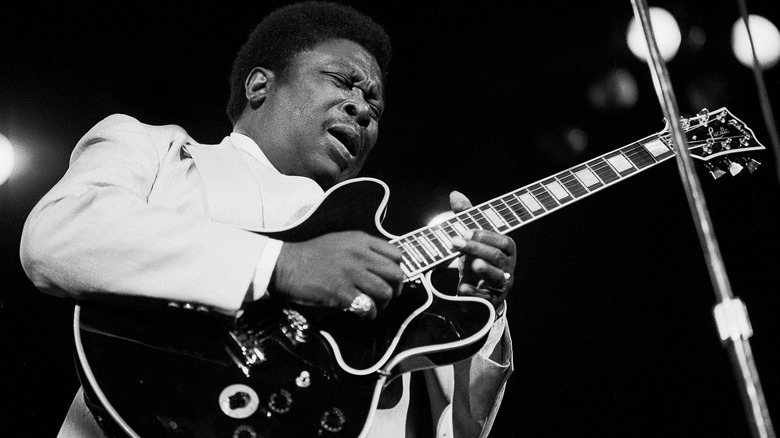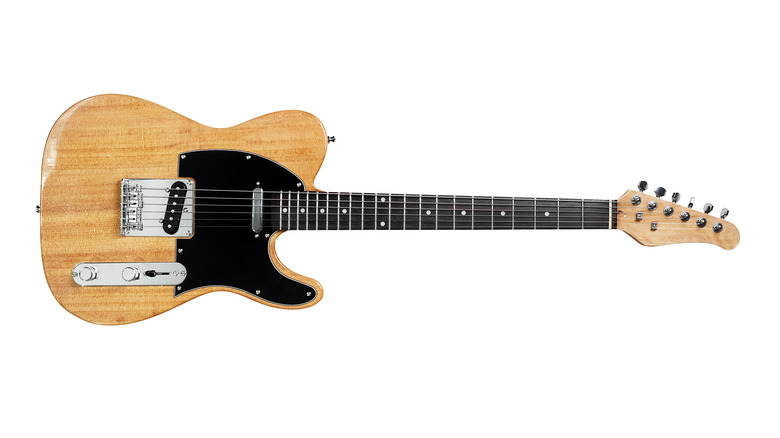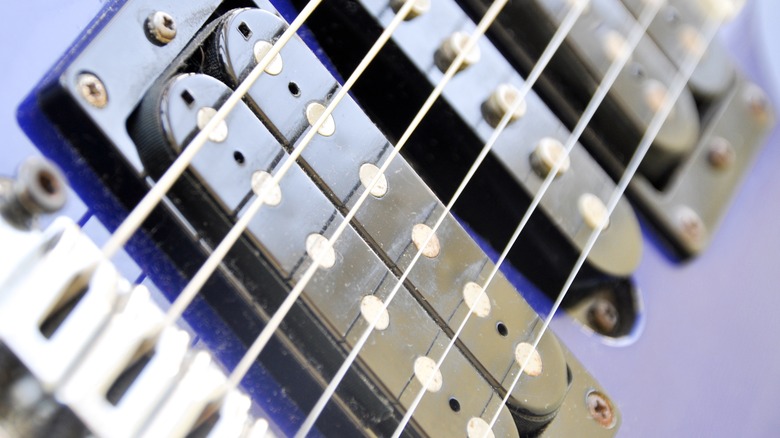How To Pick Which Type Of Electric Guitar Is Best For You
Whether you're just starting out on guitar, or have been playing for decades, choosing a guitar to buy is a daunting choice, due to sheer numbers. There are so many guitar models out there, in every shape, made of every kind of wood, with all manner of different hardware to choose from — it's a nice problem to have, but it can be a little overwhelming. Breaking down a guitar into its components can help you home in on the ideal guitar for you.
Of course, the first thing you have to talk about is price. Not because it's fun, but because it determines which models you'll be looking at more than any other of a guitar's features. If you have a beginner budget, it does you no good to look at multi-thousand-dollar guitars, except to dream about the future. Realizing what your price ceiling is can help you get the most for your money. Now let's talk about the guitar itself.
Body types
Without getting too much into the usual iconic guitar models, there are three major types of electric guitar:
- Hollow-body guitars are hollow inside, like an acoustic guitar, and have sound holes. The resonance produced by this body cavity helps to shape the sound of the guitar, providing a woody richness, appropriate for country music and blues. A famous hollow-body guitar would be the Gibson ES-335, made immortal by the late, great B.B. King.
- Semi-hollow guitars are solid-body guitars that have had resonance chambers carved or routed into them. The top panel is then attached, producing closed, empty chambers inside what looks like a solid piece of wood (there are no sound holes). These chambers serve the same purpose as in a hollow-body, to produce resonance, while the greater amount of wood present yields increased sustain. When one thinks of semi-hollow guitars, the first model that comes to mind is the Gibson Les Paul, played by dozens of the top players in the world ever since it came out, including its inventor, Mr. Les Paul.
- Solid-body guitars constitute the majority of electric guitars sold today. Made primarily for pop and rock musicians, solid-bodies trade resonance for increased sustain while playing (although many players augment their tone with effects pedals). And when you are done playing, a solid-body can be modified or repaired much more easily and cheaply than the previous two types. They are also less expensive to produce, since there is less woodwork involved. When you combine these economies, the popularity of the solid-body is easy to understand. The quintessential solid-body electric guitar is the Fender Stratocaster, played by Ritchie Blackmore, Eric Clapton, and the legendary Jimi Hendrix.
Neck types
An electric guitar's neck is the most critical part of the guitar from the perspective of comfort. Comfort while playing is important because a comfortable player plays longer, and thus gets better faster. There are three main types of guitar neck:
- The C neck: The most common kind, comfortable for most players. This neck or a modified version of it is by far the most common neck sold today, to the point where you are restricting your choice greatly by insisting on another type. If you look at a capital C, it's easy to realize why it's a good shape for a guitar neck.
- The V neck: Comes to a modified point in the center of the back. Considered an "old-school" neck. Popular with players who usually have their thumbs over the top of the neck.
- The U neck: Very deep. Not popular with lead guitar players. If you have big hands and keep your thumb strictly on the back of the neck, this might be the one for you.
On top of the neck lies the fretboard. Your choice of fretboard wood greatly affects the brightness of your guitar's tone. For a brighter, trebly tone, get a maple fretboard (or a maple neck with no added fretboard). For something with a little less snap to the sound, get a rosewood or ebony fretboard.
Another important aspect of your neck is coating vs no coating. Necks that are sprayed with polyurethane on the back, or painted along with the guitar's body can be more conducive to fast playing, but there will always be purists who want to feel nothing but wood under their hands. Remember to choose your neck for comfort and playability.
Pickup types
Pickups are those squared-off quasi-microphones below the strings that make electric guitars work by converting the physical energy of vibrating strings into electricity. They are one of the most important factors in determining a guitar's tone, and probably the most important if you have a solid-body model. There are two main types of pickup:
- Single-coil pickups have one set of magnets that are wrapped by a long coil of copper wire. The coil and magnets produce the magnetic field that allows for sound pickup.
- Humbuckers have two sets of magnets and two coils that are in most cases wired in series. The two coils (in inverse phase with each other) increase gain while eliminating noise, producing a tone more easily driven to the breakup, or distortion, that many players are looking for.
Single-coils have a cleaner tone and more bite. You will often see them on a country player's Fender Telecaster for when they want that country twang in their tone. Humbuckers are pretty much made for rock, and when combined with a high-gain amplifier, produce the snarling, singing, tightly controlled sound of a good metal player. Have you ever heard Metallica? Then you've heard the sound of humbucking pickups.
Either type of pickup can be passive, relying on the amplifier or pre-amp to give the signal enough strength to be useful, or active, with a battery inside the guitar powering the pickups. Active pickups resist feedback better than passive pickups, and work better with high-gain amplifiers.
Bridge types
The bridge is sometimes an overlooked part of a guitar, especially by beginners. It's sometimes only when you realize you hate the one you have that you go looking at your options. Your two main types are tremolo bridges, which allow you to apply vibrato to your sound in a way that a fretted instrument usually can't, and fixed, or non-trem, bridges. Tremolo bars (aka whammy bars or twang bars) are used by guitarists across rock, blues, country, and big band music, mostly judiciously. These require a special tremolo bridge that allows for the strings to go back into tune accurately when the tremolo bar is released. Some of the greatest guitarists in history, such as Jimi Hendrix, Eddie Van Halen, and Adrian Belew, have incorporated extensive use of the tremolo bar into their respective virtuosic styles. There is even an aftermarket industry dedicated to tremolo systems for installation in non-trem guitars.
Fixed bridges have their devotees as well, though. Neither the Les Paul nor the Telecaster have tremolo, unless you install it. In fact, the Les Paul's bridge has a name, the Tune-o-Matic bridge, which was marketed on its ability to keep the guitar in tune, in contrast to tremolo bridges, which have been known to have tuning issues.
Make sure you don't overlook the bridge on your new guitar. Play several different types to find the one that works best for you.
Other differentiating factors
There are many parts that go into making an electric guitar. We've gone over the major components that make the guitar work and give each model its distinctive tone. Here are a couple of other parts that can affect your guitar's sound and your enjoyment in playing it:
- Tuning machines: The pegs that your guitar strings get wrapped around and the tuning keys that tune the strings do not really affect the instrument's tone, but they do affect your frustration level. If a tuning machine works well, keeping your string in tune for a long time, you spend more time learning, getting better, and enjoying your guitar. If the machine is inferior, making your strings go out of tune constantly, you spend more time tuning your guitar instead of playing it. If you see a guitar has Schaller, Sperzel, or Grover tuners, that is a good sign.
- Electronics: The potentiometers that control an electric guitar's volume and tone can be configured in different ways. Sometimes there is one tone knob for the whole guitar; sometimes there is a separate tone knob for each pickup. The same goes for volume knobs. More pots means more control over your sound at the source, but some guitarists prefer the simplicity of fewer bells and whistles. Pickup selector switches let you turn individual pickups on and off, so their configuration and placement on the guitar can either help or hinder your playing style.
As a parting piece of advice, try as many different guitars as you can before deciding on one. Don't let anyone in a guitar store dissuade you from trying one more model. It's your money, and you deserve value for it, even if you're buying your very first guitar. Best of luck!





